- Home
- War in the Middle East
- 'Scorched Earth', Israel's War on Lebanon's Environment
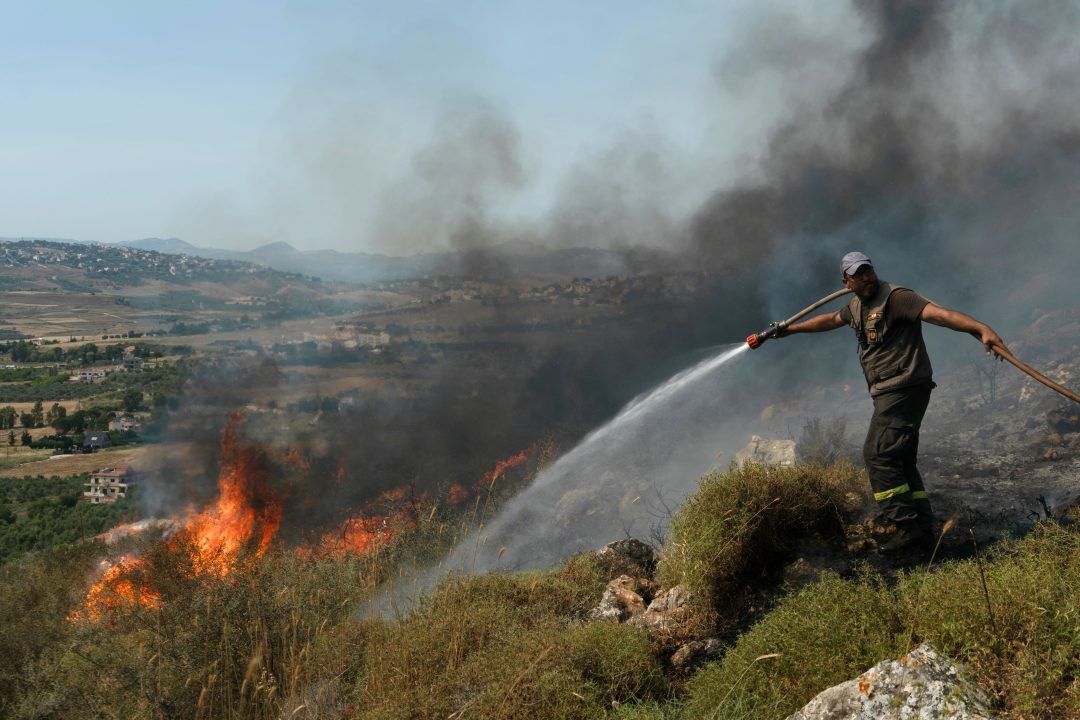
©A Lebanese firefighter douses a fire that swept over fields hit by Israeli shelling in southern Lebanon near the border with Israel, on June 3, 2024 (Hassan FNEICH / AFP)
Israel's attacks on Lebanon have left the border area a "scorched earth", as it targets the environment in the hope of creating an uninhabitable ‘security’ zone.
“Everyone has left out of fear of the war, nobody can live under the bombing, there is no life here anymore,” says Michel , a farmer from the border village of Wazzani.
Ten months of war have left southern Lebanon a “scorched earth,” Hicham Younes, the head of the Green Southerners, a Lebanese environmental NGO, told This is Beirut.
The human toll has been severe - 116 civilians have been killed according to AFP’s latest tally, and over 100,000 displaced. Yet, Israel’s strategy is multidimensional, inflicting not just a human cost, but rendering Lebanon’s environment yet another ‘martyr’.
But Michel will not let war force him from his land, “[it] is the work of my lifetime, my whole life I have tried to build a heaven, how can I just leave it behind.”
 Firefighters putting out fires in Blida, photo from The Green Southerners
Firefighters putting out fires in Blida, photo from The Green Southerners
As Lebanon balances on the edge of a precipice, the scope of the war, and the environmental devastation wrought upon the country, has been growing for months.
According to Lebanon’s National Early Warning System Platform (NEWSP), 17 million square meters of land have been damaged since October - equivalent to 2381 soccer fields - a figure that has doubled since January.
Such destruction has had dire effects for a region renowned for its diverse ecosystems and unique landscapes, says Younes, adding that southern Lebanon “provides crucial habitats for various endangered species, including sea turtles, sharks and the Mediterranean monk seal." "The region's ancient oak forests also offer refuge to endangered striped hyenas, golden jackals and Egyptian mongoose.”
The war is putting these vital natural habitats under threat with “the significant loss of bushlands, old oak and pine forests … causing local biodiversity degradation, and soil contamination.”
Younes believes that Israel “aims to damage agriculture and natural habitats, disrupt the local ecology with the goal of making the area uninhabitable.”
One of the most pernicious effects has come from wildfires, which have become increasingly prominent over southern Lebanon’s hot dry summer.
Ameneh Mehvar, a researcher at the Armed Conflict Location and Event Data Project (ACLED) told This is Beirut that they have recorded over 6,400 Israeli attacks on Lebanon since October, and that “these attacks have caused extensive forest and farmland fires” with at least 125 incidents documented over the last 10 months.
She adds that “dozens of fires have broken out due to Israel’s use of highly incendiary munitions, including white phosphorus.”
 White phosphorus deployed over Kfar Kila, from AFP
White phosphorus deployed over Kfar Kila, from AFP
Israel's indiscriminate use of white phosphorus has been condemned as ‘unlawful’ by Human Rights Watch.
This is Beirut spoke to Antoine Kallab, Associate Director of the American University of Beirut’s Nature Conservation Center, who, alongside Leila Rossa Maouwad, wrote a report on the impact of white phosphorus.
According to Kallab, white phosphorus “has a legitimate use to camouflage the movement of soldiers.” However, “there are no troops directly on the border, and its use in villages, businesses and homes … suggests that they are using this weapon for its other characteristics.”
White phosphorus “generates intensely toxic reactions at a high temperature that can cause damage to the human body, as well as the ecosystem, agriculture and land. The heat is intense enough to burn down property, forests, vegetative areas - as well as humans” says Kallab.
In June, Lebanon submitted a formal complaint to the UN Security Council condemning Israel’s use of white phosphorus to deliberately burn woods and forests.
According to the Green Southerners, its danger comes both from direct exposure to its toxic burns, and as a potentially long-term ‘environmental contaminate’.
Kallab found in his report, that it may lead to soil acidification, and contamination of water supplies, which can significantly damage agricultural viability due to flora suffering from desiccation, dieback and wilting.
Whilst, it is difficult to ascertain the true scale of damage in Lebanon, says Kallab, because systematic analysis is currently too dangerous, studies from Ukraine have found its use there to have left a considerable impact.
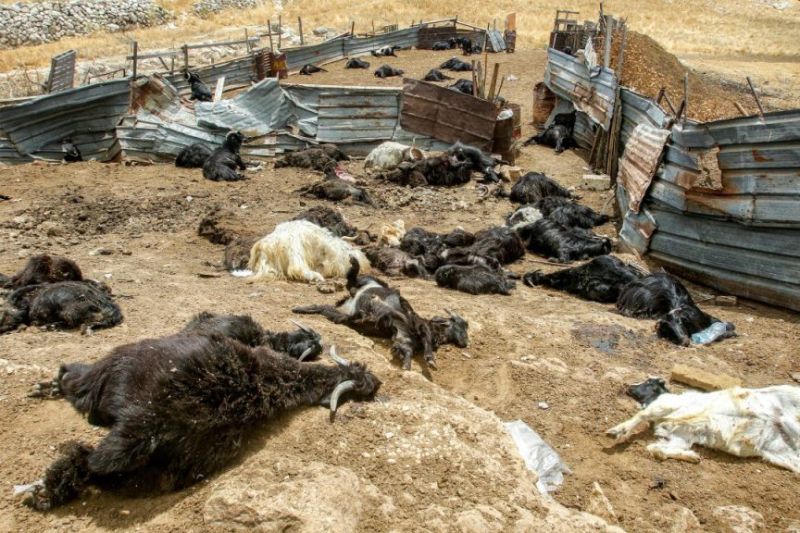 Livestock killed in an Israeli attack in Jezzine, from AFP
Livestock killed in an Israeli attack in Jezzine, from AFP
In the words of Prime Minister Najib Mikati, southern Lebanon has become an “agricultural disaster zone.”
According to the UNDP, southern Lebanon is a key agricultural center, accounting for almost 22% of the country's agricultural land, and 80% of the region's economy.
Mikati reported that 800 hectares of agricultural land have been completely destroyed alongside 34,000 head of livestock, with a 75% loss of income for local farmers.
In July, a single drone strike on a farm in Jezzine killed 300 animals, reportedly worth $100,000.
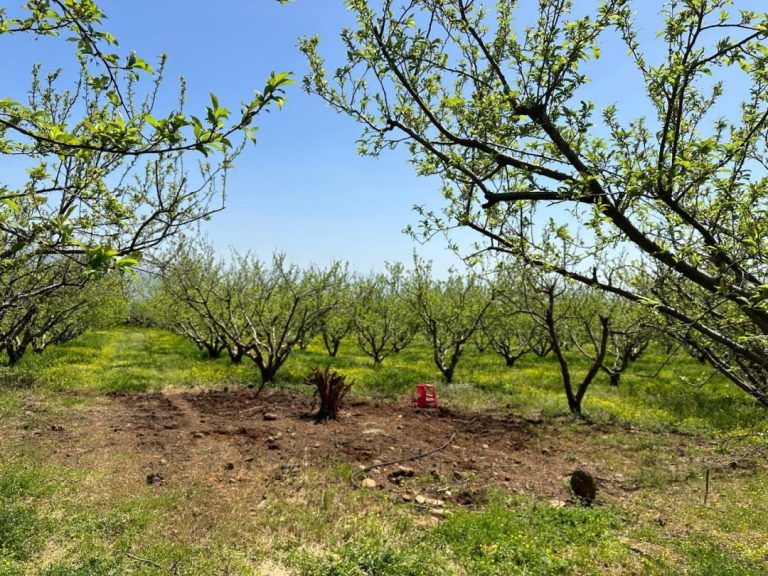 Destroyed fruit tree, photo provided by Michel
Destroyed fruit tree, photo provided by Michel
For Michel, the last 10 months have brought hardship. “We can’t give the land the same attention. We try to remove weeds, to fertilize, to spray the trees [with pesticide], but we do it fast because when the Israeli bombing starts we have to stop.”
“We can’t access part of our land because it's too dangerous, about 300 dunums of nectarine and plum trees aren’t accessible, that is around 600 tones of fruit we can’t harvest.”
As the war makes it harder to farm, basic costs are rising. “I used to get our tools from Kfar Kila, but now Kfar Kila is totally destroyed, so we have to go to Nabatieh … but things are getting more expensive and I am accruing debts,” says Michel.
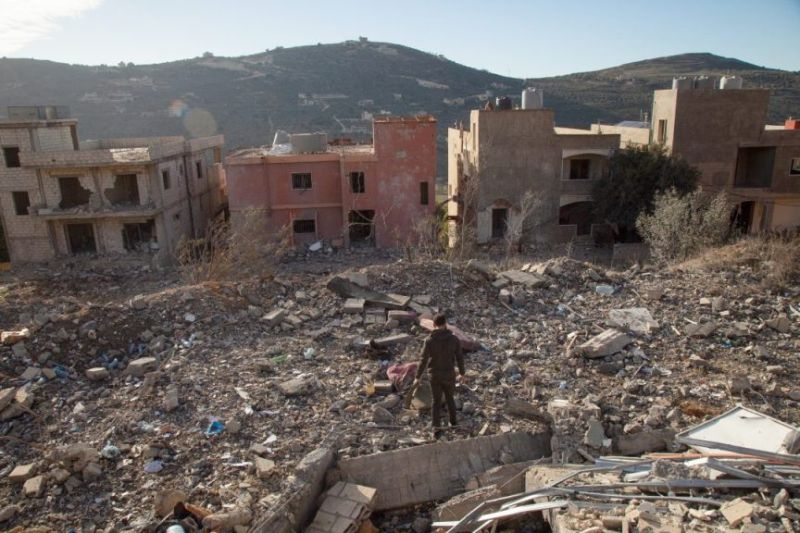 A man inspects rubble of a destroyed house in Kfar Kila, from AFP
A man inspects rubble of a destroyed house in Kfar Kila, from AFP
According to Action Against Hunger, 47,000 olive trees have been destroyed. For Younes, the impact is profound because “some olive groves are hundreds of years old and deeply intertwined with the local identity. Harming these perennial trees is akin to harming the roots of the communities.”
With over 100,000 displaced, the region is largely empty.
“There is nobody on the roads, there is no one left, it is all empty … all of them have been displaced from their land, homes and villages, they left everything behind and fled,” says Michel.
According to Kallab, such displacement disrupts the natural patterns of life “destroying the interlinkages between communities, and their inherited sense of history and culture in a place.”
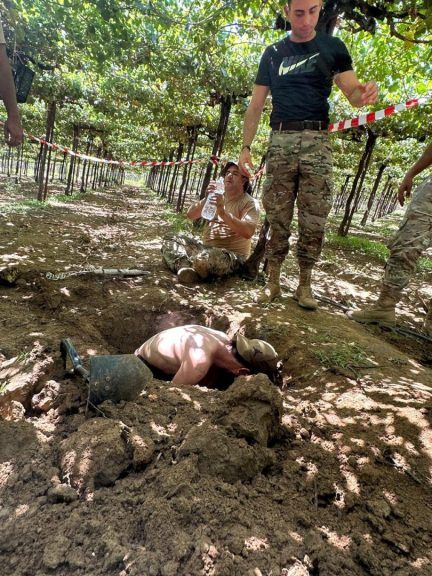 Lebanese army removing unexploded ordnance, photo provided by Michel
Lebanese army removing unexploded ordnance, photo provided by Michel
The question remains as to why Israel has put Lebanon’s environment in its crosshairs.
According to Kallab, “when you target the natural environment, you target a community's ability to remain in that environment, … when you target the land's ability to grow food, the farmer and the community around them can no longer survive - they have to move.”
"Whilst one can hypothesize Israel's intentions, the fundamental problem, when targeting the environment, is that you can’t distinguish between civilians and combatants. It is a way to punish local communities for Hezbollah’s actions, in an attempt to shift support away from the group." adds Kallab.
Does the deliberate, extensive and systematic destruction of the environment could constitute an ecocide (environmental genocide)?
According to Maud Sarlieve, an international human rights and criminal lawyer, a legal definition of ecocide does not exist.
“It’s a concept, it's not law” says Sarlieve, "the fundamental problem is how do you define ‘environmental destruction’... Does an individual chopping down a tree count as ecocide?”
She points out that “in the context of war, environmental destruction is often the lowest priority, and so we can use the concept [of ecocide] to mobilize interest in the environmental impact of war, in order to strengthen the existing protections on the environment.”
Whilst they do exist, “the protections have not been used to hold States responsible for environmental damage in times of conflict."
However, according to Sarlieve, this is a developing field of international law, and recent cases relating to Ukraine and Palestine may open up pathways for justice in the future.
“Everyone has left out of fear of the war, nobody can live under the bombing, there is no life here anymore,” says Michel , a farmer from the border village of Wazzani.
Ten months of war have left southern Lebanon a “scorched earth,” Hicham Younes, the head of the Green Southerners, a Lebanese environmental NGO, told This is Beirut.
The human toll has been severe - 116 civilians have been killed according to AFP’s latest tally, and over 100,000 displaced. Yet, Israel’s strategy is multidimensional, inflicting not just a human cost, but rendering Lebanon’s environment yet another ‘martyr’.
But Michel will not let war force him from his land, “[it] is the work of my lifetime, my whole life I have tried to build a heaven, how can I just leave it behind.”
Nature under threat
 Firefighters putting out fires in Blida, photo from The Green Southerners
Firefighters putting out fires in Blida, photo from The Green SouthernersAs Lebanon balances on the edge of a precipice, the scope of the war, and the environmental devastation wrought upon the country, has been growing for months.
According to Lebanon’s National Early Warning System Platform (NEWSP), 17 million square meters of land have been damaged since October - equivalent to 2381 soccer fields - a figure that has doubled since January.
Such destruction has had dire effects for a region renowned for its diverse ecosystems and unique landscapes, says Younes, adding that southern Lebanon “provides crucial habitats for various endangered species, including sea turtles, sharks and the Mediterranean monk seal." "The region's ancient oak forests also offer refuge to endangered striped hyenas, golden jackals and Egyptian mongoose.”
The war is putting these vital natural habitats under threat with “the significant loss of bushlands, old oak and pine forests … causing local biodiversity degradation, and soil contamination.”
Younes believes that Israel “aims to damage agriculture and natural habitats, disrupt the local ecology with the goal of making the area uninhabitable.”
One of the most pernicious effects has come from wildfires, which have become increasingly prominent over southern Lebanon’s hot dry summer.
Ameneh Mehvar, a researcher at the Armed Conflict Location and Event Data Project (ACLED) told This is Beirut that they have recorded over 6,400 Israeli attacks on Lebanon since October, and that “these attacks have caused extensive forest and farmland fires” with at least 125 incidents documented over the last 10 months.
She adds that “dozens of fires have broken out due to Israel’s use of highly incendiary munitions, including white phosphorus.”
White phosphorus
 White phosphorus deployed over Kfar Kila, from AFP
White phosphorus deployed over Kfar Kila, from AFPIsrael's indiscriminate use of white phosphorus has been condemned as ‘unlawful’ by Human Rights Watch.
This is Beirut spoke to Antoine Kallab, Associate Director of the American University of Beirut’s Nature Conservation Center, who, alongside Leila Rossa Maouwad, wrote a report on the impact of white phosphorus.
According to Kallab, white phosphorus “has a legitimate use to camouflage the movement of soldiers.” However, “there are no troops directly on the border, and its use in villages, businesses and homes … suggests that they are using this weapon for its other characteristics.”
White phosphorus “generates intensely toxic reactions at a high temperature that can cause damage to the human body, as well as the ecosystem, agriculture and land. The heat is intense enough to burn down property, forests, vegetative areas - as well as humans” says Kallab.
In June, Lebanon submitted a formal complaint to the UN Security Council condemning Israel’s use of white phosphorus to deliberately burn woods and forests.
According to the Green Southerners, its danger comes both from direct exposure to its toxic burns, and as a potentially long-term ‘environmental contaminate’.
Kallab found in his report, that it may lead to soil acidification, and contamination of water supplies, which can significantly damage agricultural viability due to flora suffering from desiccation, dieback and wilting.
Whilst, it is difficult to ascertain the true scale of damage in Lebanon, says Kallab, because systematic analysis is currently too dangerous, studies from Ukraine have found its use there to have left a considerable impact.
An agricultural disaster zone
 Livestock killed in an Israeli attack in Jezzine, from AFP
Livestock killed in an Israeli attack in Jezzine, from AFPIn the words of Prime Minister Najib Mikati, southern Lebanon has become an “agricultural disaster zone.”
According to the UNDP, southern Lebanon is a key agricultural center, accounting for almost 22% of the country's agricultural land, and 80% of the region's economy.
Mikati reported that 800 hectares of agricultural land have been completely destroyed alongside 34,000 head of livestock, with a 75% loss of income for local farmers.
In July, a single drone strike on a farm in Jezzine killed 300 animals, reportedly worth $100,000.
 Destroyed fruit tree, photo provided by Michel
Destroyed fruit tree, photo provided by MichelFor Michel, the last 10 months have brought hardship. “We can’t give the land the same attention. We try to remove weeds, to fertilize, to spray the trees [with pesticide], but we do it fast because when the Israeli bombing starts we have to stop.”
“We can’t access part of our land because it's too dangerous, about 300 dunums of nectarine and plum trees aren’t accessible, that is around 600 tones of fruit we can’t harvest.”
As the war makes it harder to farm, basic costs are rising. “I used to get our tools from Kfar Kila, but now Kfar Kila is totally destroyed, so we have to go to Nabatieh … but things are getting more expensive and I am accruing debts,” says Michel.
Harming the roots of communities
 A man inspects rubble of a destroyed house in Kfar Kila, from AFP
A man inspects rubble of a destroyed house in Kfar Kila, from AFPAccording to Action Against Hunger, 47,000 olive trees have been destroyed. For Younes, the impact is profound because “some olive groves are hundreds of years old and deeply intertwined with the local identity. Harming these perennial trees is akin to harming the roots of the communities.”
With over 100,000 displaced, the region is largely empty.
“There is nobody on the roads, there is no one left, it is all empty … all of them have been displaced from their land, homes and villages, they left everything behind and fled,” says Michel.
According to Kallab, such displacement disrupts the natural patterns of life “destroying the interlinkages between communities, and their inherited sense of history and culture in a place.”
A scorched earth strategy
 Lebanese army removing unexploded ordnance, photo provided by Michel
Lebanese army removing unexploded ordnance, photo provided by MichelThe question remains as to why Israel has put Lebanon’s environment in its crosshairs.
According to Kallab, “when you target the natural environment, you target a community's ability to remain in that environment, … when you target the land's ability to grow food, the farmer and the community around them can no longer survive - they have to move.”
"Whilst one can hypothesize Israel's intentions, the fundamental problem, when targeting the environment, is that you can’t distinguish between civilians and combatants. It is a way to punish local communities for Hezbollah’s actions, in an attempt to shift support away from the group." adds Kallab.
Ecocide
Does the deliberate, extensive and systematic destruction of the environment could constitute an ecocide (environmental genocide)?
According to Maud Sarlieve, an international human rights and criminal lawyer, a legal definition of ecocide does not exist.
“It’s a concept, it's not law” says Sarlieve, "the fundamental problem is how do you define ‘environmental destruction’... Does an individual chopping down a tree count as ecocide?”
She points out that “in the context of war, environmental destruction is often the lowest priority, and so we can use the concept [of ecocide] to mobilize interest in the environmental impact of war, in order to strengthen the existing protections on the environment.”
Whilst they do exist, “the protections have not been used to hold States responsible for environmental damage in times of conflict."
However, according to Sarlieve, this is a developing field of international law, and recent cases relating to Ukraine and Palestine may open up pathways for justice in the future.
Read more





Comments